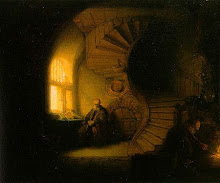On our second morning in New York we decided to go for a run in Central Park. Which I had always thought was flat. Central Park is not flat. It is quite hilly. Not big hills, but hills.
The paths in Central Park incline toward reverie. They meander. They encourage strolling. The easy, dawdling steps of the flâneur in a state of insouciant absorption. The park is antithetical to the neatly patterned efficiency of New York’s streets. Consequently, we found ourselves having to switch trails frequently in order to match our goal of doing a three mile loop of the park to the labyrinthine whims and crotchets of the paths.
We encountered a section of the park called The Ramble. This was the essence of Central Park’s contrariness to the regimentations of commerce. Small secluded glades, hollowed out of rocky outcrops of glacially-scarred Manhattan bedrock, charm the north shore of The Lake. It is densely wooded with black locust, serviceberry, shagbark hickory, American holly and black cherry. One of the paths is named “Poet’s Alley.”
I particularly liked the bridges. The Ramble Arch, for instance, is a small stone bridge under which The Gill, a tiny stream, burbles beneath. It looks like something out of a fairy tale. A story of forbidden love in sixteenth-century Prague. A romance between a saleswoman and a quixotic frog. The birth of a metaphor amid the idleness of indigo swans.
It was cold. We stopped at a runner’s shop on the way back to our hotel. I saw a jacket that was a little heavier and warmer than the light blue nylon jacket I brought with me, but they wanted a $100 bucks for it. Roberta bought a hat for $26 dollars. It was black, and suitable for any occasion. She looked good in it.
We showered and dressed and went to breakfast at Nice Matin. There was a door in the lobby next to the elevators that led directly into the restaurant.
We really enjoyed this place. We’d had dinner there the night before. It was festive and noisy and crowded and busy. I had the pasta forté, bacon, dandelion, tomatoes, ricotta, garlic and jalapeño. It was spicy and filling.
What I liked best were the nonalcoholic beverages. Few restaurants take the trouble to offer any good nonalcoholic drinks. I find this frustrating and strange. Not a few waiters turn perplexed when I ask for something nonalcoholic. They rattle off a list of pedestrian substitutes, Coca Cola or ginger ale, with absolute dreariness. The spirit goes out of you. Everyone else is provided with a list of wine and cocktails of extraordinary diversity: banana daiquiri, sea breeze, gin fizz, tequila sunrise, Japanese slipper, golden dream, rusty nail, mimosa, etc.
We non-alcoholic beverage drinkers need beverages with panache. Mixtures of grenadine and ginger ale. Names like Beads Of Nebulous Dream. Flash Burn. Inertial Guidance. Eternal Passion. Pullulating Ladders Of Scintillating Foam. Cochineal Cock-A-Doo. Arapaho Peach.
Italian sodas are excellent. But strangely, few restaurants offer them. Pasta Bella, here in Seattle, on upper Queen Anne, makes wonderful Italian sodas with a broad range of flavors.
Chinook’s, by Seattle’s Fisherman’s Terminal, offers some tasty non-alcoholic beverages as well.
I ordered a Soleil du Tropique which was delicious. I can’t remember what was in it, but it sure was good.
We entered the park at 79th Street and meandered east. We stopped by a house that looked like something out of a fairy tale, a Baltic fir log cottage which was transported to the United States from Sweden and exhibited at the U.S. Centennial Exposition in Philadelphia in 1876. The structure was showcased as an example of Swedish woodworking. Frederick Law Olmstead, Central Park’s chief landscape architect, purchased it for $1,500 and had it taken apart, transported to New York City, and reassembled at its present site in 1877. It was first used as a tool house, then a library, then a comfort station and lunchroom, then an entomological laboratory, then the district headquarters for the Civil Defense during WWII, and finally, in 1947, Mayor Fiorello LaGuardia and Parks Commissioner Robert Moses established it as the official workshop for the Park Department’s Traveling Marionette Theatre. In 1970, a permanent theatre was constructed inside, and it continues to this day to present marionette performances, classic tales like The Magic Flute, Rumpelstiltskin, Jack and the Beanstalk, Cinderella and Sleeping Beauty.
A young black woman happened by and asked us to take her picture. She had an accent, and I wondered if she might be from French-speaking Senegal, Cameroon, or Ivory Coast. I craved hearing French. I’ve grown accustomed to hearing French every day on TV5. I didn’t think I would miss hearing it so much.
The woman handed me her camera and I looked through the viewfinder, which was blank. I said I couldn’t see anything in the viewfinder. Roberta told me to look down. I looked down and saw the woman in a screen. She smiled sweetly, and I snapped her picture.
There was a garden next to the cottage with several plaques featuring quotes from Shakespeare concerning flowers. “A Rose by any other name would smell as sweet.” “That strain again! it had a dying fall: / Oh, it came o’er my ear like the sweet sound / That breathes upon a bank of violets / Stealing and giving odors.”
As we leaned over the rail to read Orsino’s words on the copper plaque, one of New York’s finest came trotting by on a beautiful brown horse. The sun was out, and the sheen on the horse’s body coruscated as the horse and cop trotted by at a vigorous clip.
Our next stop was Belvedere Castle.
Monday, November 8, 2010
Subscribe to:
Post Comments (Atom)


No comments:
Post a Comment